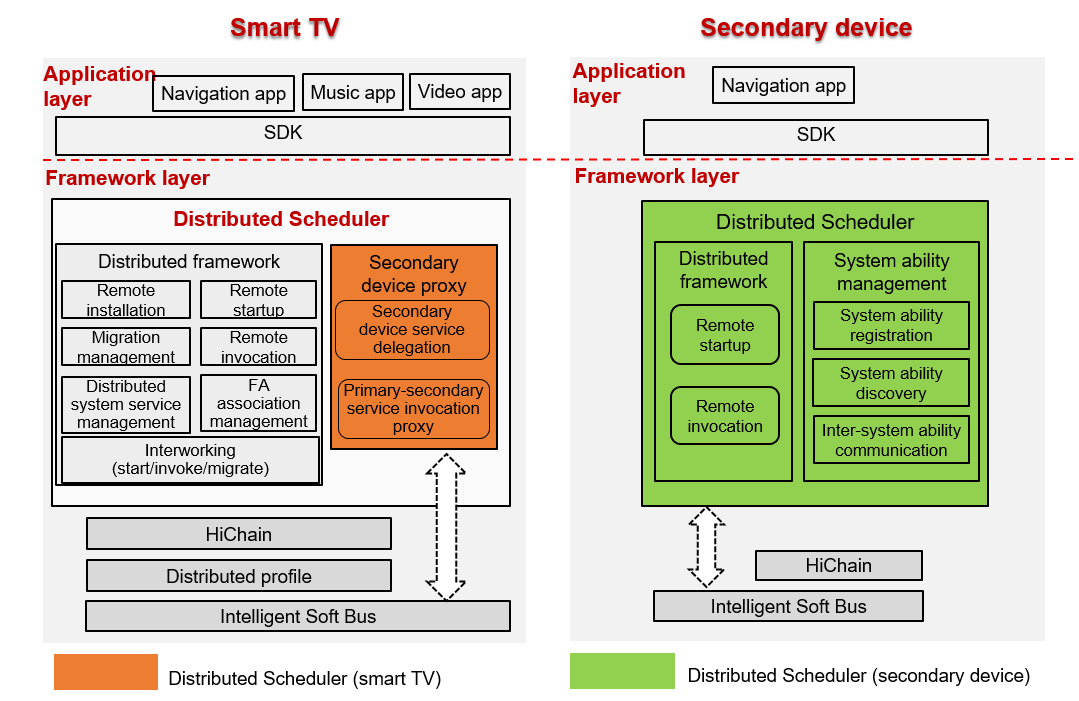# Distributed Scheduler
- [Introduction](#section11660541593)
- [Directory Structure](#section1464106163817)
- [Constraints](#section1718733212019)
- [Usage](#section10729231131110)
- [Repositories Involved](#section176111311166)
## Introduction
The Distributed Scheduler is used for cross-device component management. It allows the local device to access or control remote components, and enables application collaboration in distributed scenarios. The following figure shows the modules in the Distributed Scheduler.

## Directory Structure
The following table describes the directory structure of the Distributed Scheduler.
**Table 1** Directory structure of the major source code
Directory
Description
dmsfwk_lite
Implementation of the Distributed Scheduler
safwk_lite
Implementation of the foundation process
samgr_lite
Implementation of system ability framework
## Constraints
**Language**: C or C++
**Networking environment**: The primary and secondary devices must be on the same LAN and can ping each other.
**Operating system**: OpenHarmony
**Limitations and constraints on remote startup**:
- Only Feature Abilities \(FAs\) can be started remotely. Remote startup is unavailable to abilities using the Service template.
- Before the remote startup, ensure that the distributed networking between the primary and secondary devices is successful. Otherwise, the remote startup fails.
## Usage
- **Compiling and Building the Distributed Scheduler**
The code of the Distributed Scheduler is stored in the following directory:
```
foundation/distributedschedule/services/dtbschedmgr_lite
```
When compiling and building the code for a specific platform, you need to specify the target platform. The following code snippet uses code compilation and building for the Hi3516 DV300 platform as an example:
```
python build.py ipcamera -p hi3516dv300_liteos_a
```
- **Primary device development** \(taking FA startup as an example\)
Create a **Want** instance to set the remote device ID, bundle name, and ability class name of the target FA and set the **Want.FLAG\_ABILITYSLICE\_MULTI\_DEVICE** flag to enable distributed startup.
```
import ohos.aafwk.ability.Ability;
import ohos.aafwk.content.Want;
import ohos.bundle.ElementName;
// Create a Want instance that will be passed to the startAbility method.
Want want = new Want();
ElementName name = new ElementName(remote_device_id, "com.huawei.remote_bundle_name", "remote_ability_name");
want.setElement(name); // Add information about the target FA for startup to the Want instance.
want.setFlags(Want.FLAG_ABILITYSLICE_MULTI_DEVICE); // Set the multi-device startup flag. If this flag is not set, remote FA startup will be unavailable.
// Start the remote FA on the secondary device.
startAbility(want); // Start the specified FA based on the want parameter. If the name and type of the want parameter are different from those used in the IDE, use the parameter name and type in the IDE.
```
- **Prerequisites**
The target FA with the specified bundle name must have been installed on the secondary device.
- **Execution** \(taking FA startup as an example\)
Call the **startAbility** method on the primary device to start the target FA on the secondary device.
## Repositories Involved
[Distributed scheduler](https://gitee.com/openharmony/docs/blob/master/readme/distributedschedule/dmslite.md)
[System ability framework](https://gitee.com/openharmony/docs/blob/master/readme/distributedschedule/samgrlite.md)